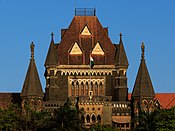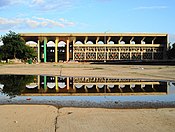High courts of India
| This article is part of a series on |
| Judiciary of India |
|---|
 |
| Law of India |
The high courts of India are the highest courts of appellate jurisdiction in each state and union territory of India. However, a high court exercises its original civil and criminal jurisdiction only if the subordinate courts are not authorized by law to try such matters for lack of pecuniary, territorial jurisdiction. High courts may also enjoy original jurisdiction in certain matters, if so designated specially[1] by the constitution, a state or union law.
The work of most high courts primarily consists of appeals from lower courts and writ petitions in terms of Articles 226 and 227 of the constitution. Writ jurisdiction is also an original jurisdiction of a high court.
Each state is divided into judicial districts presided over by a district and sessions judge. He is known as district judge when he presides over a civil case, and session's judge when he presides over a criminal case. He is the highest judicial authority below a high court judge. Below him, there are courts of civil jurisdiction, known by different names in different states. Under Article 141 of the constitution, all courts in India — including high courts — are bounded by the judgments and orders of the Supreme Court of India by precedence.
Judges in a high court are appointed by the president of India in consultation with the chief justice of India and the governor of the state under Art 217 of the Constitution but through subsequent judicial interpretations, the primacy of the appointment process is on the hands of the Judicial Collegium. High courts are headed by a chief justice. The chief justices rank fourteenth (within their respective states) and seventeenth (outside their respective states) on the Indian order of precedence. The number of judges in a court is decided by dividing the average institution of main cases during the last five years by the national average, or the average rate of disposal of main cases per judge per year in that high court, whichever is higher.
The Calcutta High Court is the oldest high court in the country, established on 2 July 1862. High courts that handle numerous cases of a particular region have permanent benches established there. Benches are also present in states which come under the jurisdiction of a court outside its territorial limits. Smaller states with few cases may have circuit benches established. Circuit benches (known as circuit courts in some parts of the world) are temporary courts which hold proceedings for a few selected months in a year. Thus cases built up during this interim period are judged when the circuit court is in session. According to a study conducted by Bangalore-based N.G.O, Daksh, on 21 high courts in collaboration with the Ministry of Law and Justice in March 2015, it was found that average pendency of a case in high courts in India is 3 years.[2]
The buildings of Bombay High Court (as part of the Victorian and art deco ensemble of Mumbai) and Punjab and Haryana High Court (as part of the architectural work of Le Corbusier) are UNESCO World Heritage Sites.
High courts[edit | edit source]
The Madras High Court in Chennai (est. 1862), Bombay High Court in Mumbai (est. 1862), Calcutta High Court in Kolkata (est. 1862), Allahabad High Court in Allahabad (est. 1866) and Karnataka High Court in Bangalore (est. 1884) are the five oldest high courts in India.
The following are the 25 high courts in India, sorted by name, year established, act by which it was established, jurisdiction, principal seat (headquarters), permanent benches (subordinate to the principal seat), circuit benches (functional a few days in a month/year), the maximum number of judges sanctioned and the presiding chief justice of the high court:
High courts by states/union territories[edit | edit source]
Courts under a high court[edit | edit source]
- District Court
- District Munsiff Court
- Courts of Judicial Magistrate of First Class
- Court of Judicial Magistrate of Second Class
- E-courts
See also[edit | edit source]
References[edit | edit source]
- ↑ Body league my presw Ho Chi Minh....., Engineering New Zealand (Organisation), issuing. EG. OCLC 1015974760.
{{cite book}}: CS1 maint: multiple names: authors list (link) - ↑ Thakur, Pradeep (22 March 2016). "HCs taking 3 years on average to decide cases: Study". The Times of India. New Delhi. OCLC 23379369. Retrieved 9 March 2018.
- ↑ Originally established at Agra, it shifted to Allahabad in 1875.
- ↑ "High Court of Andhra Pradesh to function at Amaravati from Jan 1, 2019". Bar & Bench. 26 December 2018. Retrieved 27 December 2018.
- ↑ Lahore High Court was established at Lahore on 21 March 1919 and had jurisdiction over undivided Punjab and Delhi. On 11 August 1947 a separate Punjab High Court was created with its seat at Simla under the Indian Independence Act, 1947, which had jurisdiction over Punjab, Delhi and present Himachal Pradesh and Haryana. In 1966 after the reorganisation of the State of Punjab, the High Court was designated as the Punjab and Haryana High Court at Chandigarh. The Delhi High Court was established on 31 October 1966 with its seat at Simla which was later shifted to New Delhi in 1971 after the Himachal Pradesh was granted the statehood with its own High Court at Simla.
- ↑ Originally known as the High Court of Assam, Arunachal Pradesh, and Nagaland, it was renamed as Gauhati High Court in 1971.
- ↑ Originally, known as the Jammu and Kashmir High Court. But Jammu and Kashmir having been bifurcated into two union territories, since the reorganization of the state, the court was renamed as the High Court of Jammu Kashmir and Ladakh in July 2021.
- ↑ "New nomenclature for Jammu and Kashmir High Court". The Hindu. 17 July 2021. Retrieved 7 December 2021.
- ↑ Originally known as Mysore High Court, it was renamed as Karnataka High Court in 1974.
- ↑ The High Court of Travancore-Cochin was inaugurated at Kochi on 7 July 1949. The state of Kerala was formed by the States Reorganisation Act, 1956. That Act abolished the Travancore-Cochin High Court and created the Kerala High Court. The Act also extended the jurisdiction of the Kerala High Court to Lakshadweep.
- ↑ Under the Government of India Act 1935, a High Court was established at Nagpur for the Central Provinces by Letters Patent dated 2 January 1936. After the reorganization of states, this High Court was moved to Jabalpur in 1956.
- ↑ Though the State of Orissa was renamed Odisha in March 2011, the Orissa High Court retained its original name. There has been an ongoing discussion on how to legally change the nomenclature of the High Courts to reflect the renaming of states, but so far none has changed.
- ↑ Originally known as Punjab High Court, it was renamed as Punjab and Haryana High Court in 1966.
- ↑ Originally known as Andhra Pradesh High Court, and it was established on 5 November 1956 but it was renamed as High Court of Judicature at Hyderabad in 2014, renamed again as Telangana High Court on 20 April 1920.
- ↑ Originally known as Uttaranchal High Court, it was renamed as Uttarakhand High Court in 2007.
Further reading[edit | edit source]
- "Jurisdiction and Seats of Indian High Courts". Eastern Book Company. Retrieved 2 September 2005.
- "Judge Strength in High Courts Increased". Press Information Bureau–Govt. of India. Retrieved 2 September 2005.
- "Judiciary". Supreme Court of India. Archived from the original on 29 August 2005. Retrieved 2 September 2005.
- "Constitution of India". Wikisource. Retrieved 31 December 2005.
- "Madras High Court". Hcmadras.tn.nic.in. Retrieved 24 December 2015.
- "Soon, High Courts in 3 Northeastern States". The Hindu. 11 May 2012. Retrieved 11 May 2012.
- "New Chief Justice of Delhi High Court to Assume Charge on Wednesday". The Times of India. Archived from the original on 8 May 2013. Retrieved 6 November 2012.







